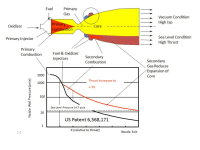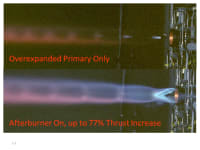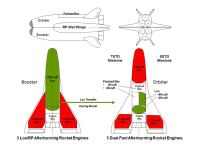
The Innovation
Launch vehicle rocket engines must operate from sea level to near-vacuum conditions. They require high thrust at takeoff when the vehicle is heaviest. As the vehicle ascends to space it requires a high specific impulse (Isp) to minimize the propellant consumption. These requirements are in conflict. Aerojet has patented an Afterburning Rocket Engine (ABRE) that provides both high thrust at lift off and high Isp in space. Figure 1 shows the ABRE concept. Combustion of additional propellants in the nozzle increases the pressure in the nozzle and thrust significantly. The higher pressure in the nozzle allows a larger nozzle area ratio which increases the vacuum Isp.
Aerojet has tested the ABRE engine in 2005. Figure 2 shows test firings with the afterburner on and off. Thrust increases up to 77% were demonstrated.
Cost-Effectiveness
The cost to put a pound of mass into orbit is about $10,000. This is mostly the expensive launch vehicle hardware that is then thrown away after one use. The ABRE can have dramatic impact on these costs.
Near Term The ABRE allows a less expensive expendable launch vehicle or increased payload for an existing vehicle. Fewer and less expensive engines are expected with a new vehicle. Costs to launch payloads may be reduced more than 50%.
Far Term The high performance and low weight of the ABRE can lead to a truly low cost and fully reusable Launch Vehicle. Figure 3 shows such a reusable Launch vehicle. This fully reusable vehicle can reduce payload cost by up to 99% of launch vehicles. This low cost, airliner like, operation can lead to a great expansion of space activities such as space tourism.
Manufacturability
Current rocket engines are extremely expensive to manufacture. The Space Shuttle Main Engine (SSME) cost about $60M each. This is largely due to the need to operate at extreme pressures and temperatures with pumps that have generate 70,000HP to feed the high pressure combustion chamber. Building an engine to survive these conditions requires the utmost in materials and processes. The slightest flaw can lead to a catastrophic explosion. At the same performance level, ABRE can operate at about half the pressure of the SSME with much lower temperatures and stresses. With the reduced environments in the ABRE, lower cost materials with lower cost fabrication processes can be employed reducing the engine costs significantly.
Marketability
The high cost of launching payloads into space has been a major deterrent to the expansion of this market. The number of engines and their performance drive the overall cost of space access. The ABRE can revolutionize space access in both the near and far term. The Afterburners can be provided as kits to retrofitted existing engines to provide performance improvement at minimum cost. When the afterburner begins flying, the market demand is expected to accelerate as all existing and new launch providers will rush to gain the benefits of the ABRE.
-
Awards
-
 2013 Top 100 Entries
2013 Top 100 Entries
Like this entry?
-
About the Entrant
- Name:Mel Bulman
- Type of entry:individual
- Patent status:patented








